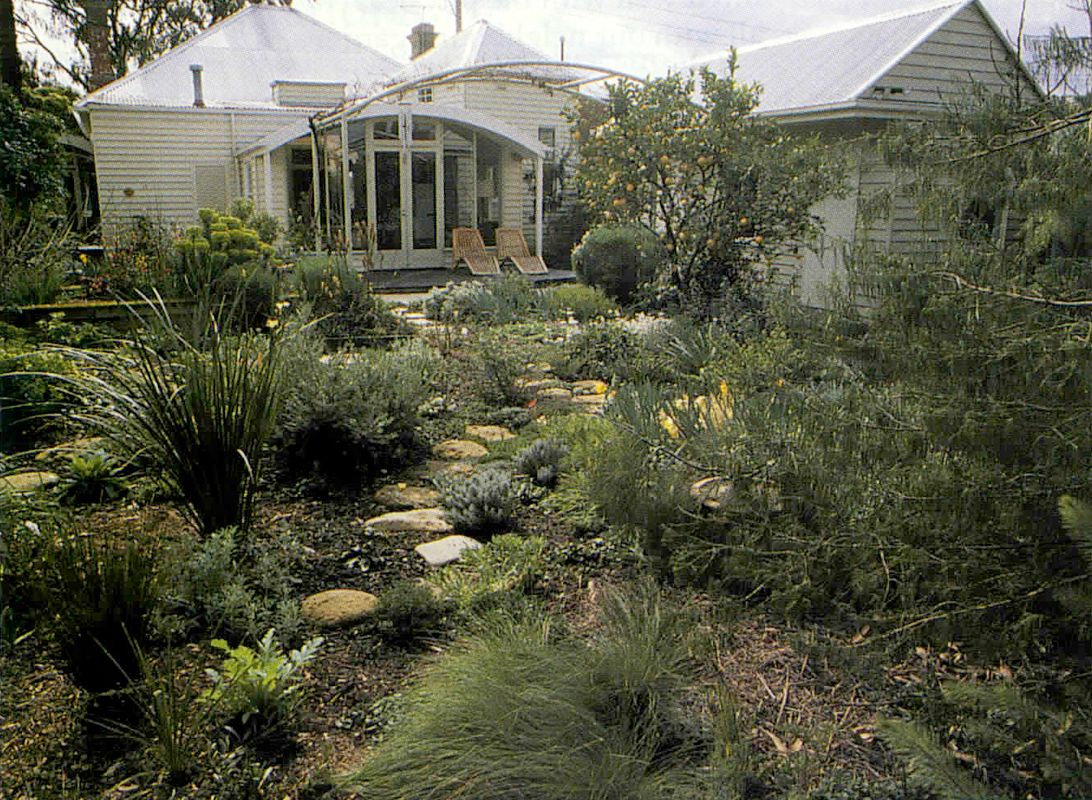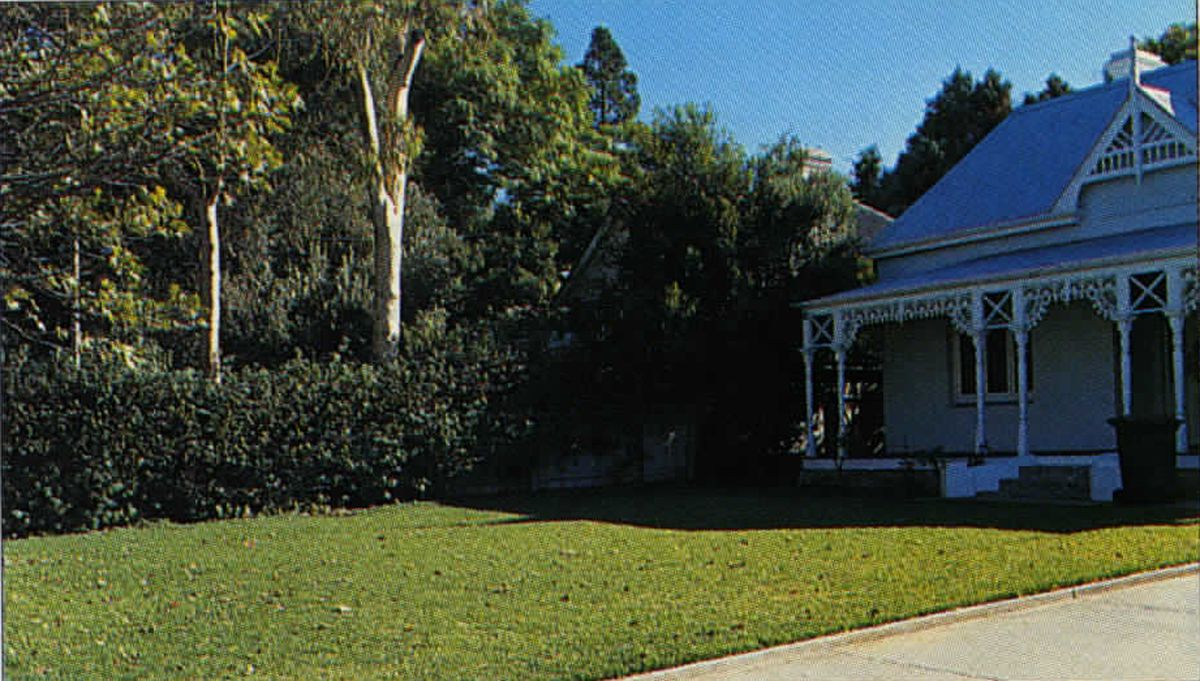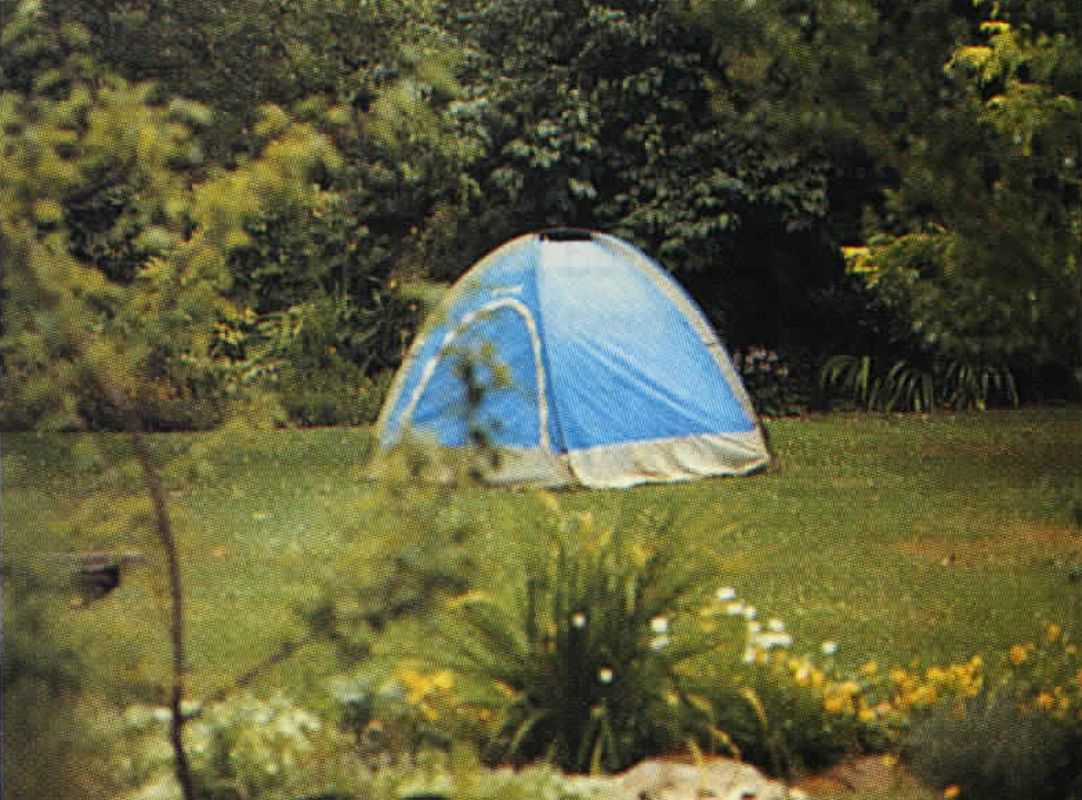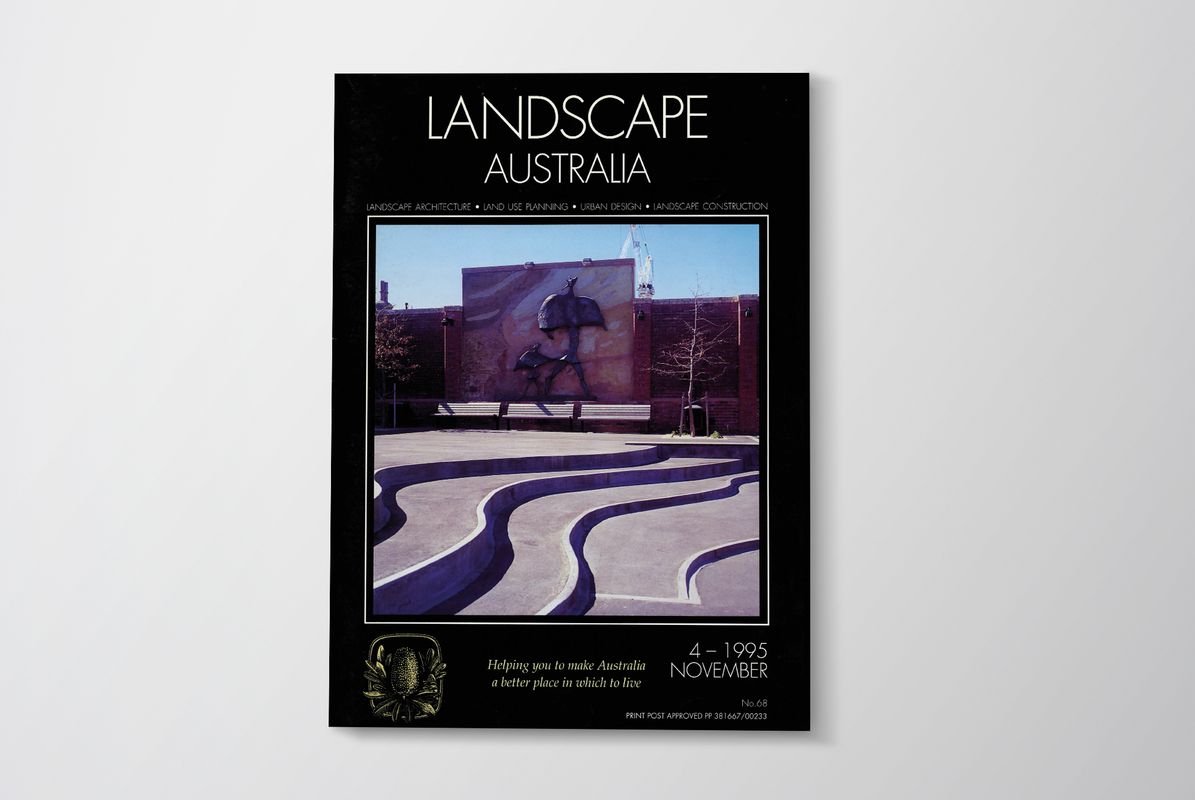Perhaps the most important benefit of gardening is the freedom to establish and define ones own territory, vital for many animals in creating confidence in the security of the immediate environment. In our own garden we can make our own decisions, give free rein to our creative impulses, make our own mistakes, and learn from them, change our minds, watch and observe the consequences of our actions, gain some insight into natural processes, and tie ourselves to the rhythm of the seasons. I don’t see how a real gardener can lose interest in life: we always want to see the wisteria bloom again in spring, or in my case, see the wonderful orange yellow flowering cones of Banksia praemorsa, and the little nectar-feeding birds that share my delight in it.
These pleasures are personal ones. You have chosen the plants, put them in the soil, cared for them; they are dependent on you, and their growth is your reward. The owners of a great estate with a garden professionally designed and maintained may take pleasure in their garden, too, but the pleasure will be of a different order.
I have made five gardens over the last 40 years. Each is different, partly because of location and climate, partly because of available resources, and partly because of changes in myself. One theme that runs through all of them is that gardens can be experimental. Another is that we learn from books, travel, and other gardens, and these generate ideas that we may like to try for ourselves. But I think that as we grow older, we also become more reflective about the influences that have fashioned our own tastes. Even when we think we are being most original, especially when young, we are often guided by our cultural background, and accept some courses of action as ‘right’, quite unthinkingly. How could it be otherwise? It takes experience and self-knowledge to learn that it could indeed be otherwise- and I shall give some examples from my own life. Yet another theme is that gardens can be resonant with associations of all kinds, and one’s knowledge can enrich these. Again, a personal example: I have had the good fortune to travel extensively. It has given me intense pleasure to see some of our garden plants in their natural setting: in China, I have seen camellias in Yunnan province growing naturally, and Anemone hupehensis along the roadside in Central China, lacecap hydrangeas again along the roadside in western Szechuan, and Magnolia liliflora on the slopes of Fuji in Japan, Arbutus unedo in the maquis of Provence and the Mediterranean littoral, with Arbutus andrachne in Greece, Arbutus menziesii in Oregon, along with Mahonia aquifolia, or the superb Protea in the Drakensberg in Natal, in southern Africa. The pleasure and excitement of seeing these plants in their natural setting is redoubled on seeing them again in my garden. The two reinforce each other, and of course, one learns something of the ecology of the plant by seeing it in its native haunts.
But I would like to know where all my plants come from, as do most dedicated gardeners, and also to know their history of cultivation, and their nursery experience also. A good knowledge of plants gives us a very concrete sense of the real world – there are few countries with which we are not able to associate a number of plants, even if we have not been there. Chile, for example, brings to mind for an Australian a list of plants that have Gondwanan origin: the bizarre Monkey-puzzle tree, for example, is Araucaria araucana – and closely related to our Norfolk Island Pine, Araucaria heterophylla, of which I have two in my garden – or the vivid Fire Tree, Embothrium coccineum, a close relative of our banksias and waratah, which it resembles, and the proteas of South Africa, all Gondwanan. And so on. I could go on indefinitely. But the point is that such knowledge is intensely personal, and personally enriching. In one’s own garden, one is in contact with the whole globe, both cognitively and imaginatively.
II
Over the last forty years, I have made five different gardens, the first in Claremont, a suburb of Perth, Western Australia; then Paddington in Sydney; then Hawthorn in Melbourne, followed by Richmond, also in Melbourne, and finally Fremantle, again in Western Australia.
My aims have evolved through time to:
- improve ecological fit.
- meet functional requirements, which have varied through time and space – e.g. play space for our children when young, a place to dry laundry, maximum summer shade in Perth, maximum winter sun in Melbourne.
- express my ‘sense of place’ – to design a garden that fits well with both the natural and the social environment. However, these were often in conflict. For instance, when we began our first garden in Perth all our neighbours hated trees, but we loved trees and planted many suited to the soil and climate. They fitted well with the physical environment, but not at all with our neighbours’ gardens.
- meet my aesthetic criteria. These have also changed with time and experience. Thus the gardens are a journey and a personal evolution.
The first garden I made, in Claremont, was around a house built in 1890 on a block a little narrower and a lot deeper than the 60ft wide block that became common a few years later. This was the first house we owned. In retrospect, I find three things of interest about that garden. The first is that we planted trees, lots of them, at a time when most Perth gardeners avoided trees, or at most had one or two. Trees were messy, they dropped leaves everywhere, which had to be raked up, they blocked the gutters, which had to be cleaned, many of them had gum, flowers or exudates which marked the roof of the car and stained bricks and paving, and above all, they shaded the roses and displays of annuals, while their roots robbed the nutriment from all around them.
We didn’t care. We loved trees, and were early members of the Tree Society, which vigorously fought the current arboriphobia. So we planted lemon-scented gum (E. citriodora) like bedding petunias; an avocado, which has been fruiting magnificently for years; three olive trees close together in the front garden because of my then prejudice about single ‘specimen’ trees; a brown plum pine (Podocarpus elata), now a very handsome tree, neighbouring an Irish Strawberry tree (Arbutus unedo), both with dark foliage. A principle I came to early in Perth is that the strong, clear light demands a strong statement from plants, and that dark cypress-green and the silvery green green of olive make a firm background, where the intermediate greens often look washed out.
Thirty-five years later, the trees are still there; so are the folk who bought the house. A few years ago, the house block was very prominent, like a single skyscraper in a flat plain – but the skyscraper was composed of tall trees rather than concrete. There is no doubt that I overplanted that block, but it was a good-hearted mistake, and now that trees are back in favour in Claremont, it doesn’t stand out so much, although the next-door neighbour on one side still has a front ‘garden’ that is nothing but bare lawn, without so much as a shrub, let alone a tree. In a way, the contrast is quite effective, since the trees that we planted make such a dense and strong backdrop.
The second item worth recording is the form of the back garden. The back of the house faces north, sunny in winter. We put in a glass wall in the main room to the rear, opening onto a paved area with pergola and vines for summer shelter, and beyond that, a lawn of tough buffalo grass (Stenotaphrum sp.) flanked on three sides by bushes and trees, so the boundaries were hidden. I now call this form ‘the clearing in the forest’, thinking of its origins, and it is a form deeply embedded in the northern races of Europe. The clearing in the forest has a primitive appeal and a primitive history. Clearings, whether natural or man-made, were a comfort zone, and they gave you a clear view of an approaching enemy, whether man or beast. The precursor of the lawn was the grass cropped by domestic animals, often tethered for safety: goat, cow, horse. The dark, encircling forest formed the boundaries. Thus the three elements of this basic form are the open lawn, the closed, dark boundary, roughly semicircular in form, and an unobstructed view to it across the grass – a view that has evolved from the view from the mouth of the cave to the picture window, but still giving primacy to one viewpoint, and hence guiding composition.
But if this form had dim ancestral appeal for me, it was not in fact typical of Perth in the sixties, nor of most of Australia, which used a form and style I have called Fletcherian, because it reaches an apogee at the Fletcher Jones headquarters outside Warrnambool in Victoria. The most obvious feature of the Fletcherian is its insistence on order. Neatness has been raised to a primary goal. Shrubs are pruned and clipped, lawns are immaculate, not a leaf out of place, there is a strong emphasis on flower colour, and a skilled succession of annual bedding plants, from Iceland poppies in winter through, say, nemesia and daffodils in spring, petunias in summer, asters and chrysanthemums in the autumn. Trees and shrubs are valued as horticultural specimens, and generally well tended by these standards. Unity of composition is subordinate to individual display, and foliage and form are subordinate to colour. The antecedents of this style are to be found in Britain, in the estates especially of the nouveaux riches and in municipal bedding displays, but also in the rapidly growing suburbs of the nineteenth century, especially in the industrial Midlands, where horticultural skills could be practised on very small housing lots, and the breeding of prize dahlias and chrysanthemums, or new cultivars of carnations, became matters of intense local pride and rivalry. The social origins of these changes are complex and obscure: they are in part a by-product of rapid industrialisation and urbanisation, and to some degree of that global colonial expansion which so increased horticultural choice, creating the global supermarket with the world’s flora on the shelves. The obsession with order, both in Britain and even more so in Australia, was in my view the obverse of the fear of disorder, in a world where the loss of respectability, from some minor misfortune or peccadillo, was irretrievable and terrible in its consequences.
I was in reaction to all this. I wrote Swan River Landscapes and A Sense of Place in the late sixties, and part of the ideas in these two books struggled for expression in the Claremont garden. I ripped out a plumbago hedge along the front boundary, which sloped down to the footpath level, and made an informal embankment with boulders of dense limestone caprock. I was in love with limestone; this was all before it became fashionable. I filled the pockets in the embankment with the various prostrate thymes, prostrate rosemary, campanula, silene, thrift, pinks, all Mediterranean, all ordered and eagerly awaited from Norgates near Trentham in Victoria. Such plants were long unavailable in the West. I continued the Mediterranean theme in those three olives and the Arbutus. The blistering summer heat took out a few of the prostrate plants, but most of them settled in happily.
My ‘sense of place’ was incomplete; it never crossed my mind to plant Templetonia retusa or Spyridium, which were probably cleared to build the house, but I did plant a chenille honey myrtle, Melaleuca hugelii, which I had admired bursting into November bloom along the limestone escarpment of Kings Park, near the Brewery (it still does it). I experimented with melaleucas, and had quite a collection, including a bed of low, almost prostrate species, such as Melaleuca violacea, M. cardiophylla with its heart-shaped leaves, and M. pulchella, with exquisite corky, twisted branches, tiny leaves, and delicate mauve claw-flowers. And on the nature-strip (or virgin strip, as Elizabeth Jolley, our diagonally adjoining back fence neighbour used to call it) I planted Melaleuca nesophila grown from seed that I had collected on the south coast in its home range. This is the earliest garden use of which I am aware, which is not to say that it is the earliest, but at least it was not on sale in the West at that time, although Lullfitz was a brave pioneer, and I bought the other melaleucas from him. Ralph Boddy at Eastern Park Nursery in Geelong may have had it by the late sixties – he had certainly collected in the West. And it may well have been in common use in California. Almost all our other beauties were, long before our nurseries carried much more than Geraldton Wax. The contorted trunk and papery bark were the attraction for me. My tree was exposed to the south-westerly gales, and it became storm-tossed as it grew, with a striking Gothic asymmetry, offending all the canons of order then prevailing. Yet by the time we left Perth, the tourist buses that included Victoria Avenue as part of their scenic route used to pause to admire my tree. It is still there, although a little the worse for wear from the loss of a limb that had to be amputated.
III
We moved from Perth to Sydney, where I took up the Chair of History and Philosophy of Science at the University of New South Wales. We bought a terrace house in Paddington immediately above the Scottish Hospital, which then had grounds that were a tangled wilderness of Port Jackson figs. The lie of the land sloped steeply down to the harbour at Rushcutters Bay, and we were about onethird of the way down from the ridge at Oxford Street, facing north, with winter sun, and protection from the cold southerly winds. Of course we were sitting on a platform of Hawkesbury sandstone, like so much of Sydney, with meagre soil, but enough to grow a terrace garden: we painted the front door a smashing burnt orange, flanked the stone steps with wooden tubs, a cumquat tree in each. We paved most of the small front yard with flagstones, except for a large pocket near the wall parapet (topped with cast-iron railings, dark green). The pocket was planted up with a group of something or other, I think Gordonia axillaris. The back garden had a big camphor laurel at one side, a pergola right across the 20ft width of the lot, with wisteria, bougainvillea, and a few other odds and ends. Most of the ground level was flagged. We were lucky to have a lane on one side and at the rear, with car access, but a terrace is a terrace, and the building form virtually dictates the garden.
IV
From Paddington, we went south. I became Director of the Centre for Environmental Studies at the University of Melbourne, and we lived in Hawthorn. Once again we were on a fairly steep slope, the northern slope to Gardiners Creek, which you encounter as Glenferrie Road swoops down from Scotch College to the creek, under the freeway, across the rail tracks, and up again to Toorak and Malvern Roads. We were two blocks east of Scotch. The front of the house faced south, and the people from whom we bought it had planted the steep slope to the street with eucalyptus, hakeas and grevilleas. We left it alone – the fairly dense planting gave privacy from the street, it needed no supplementary water, and very little weeding either, since twigs and leaf litter inhibited most growth at ground level. The trees were a mixed bag, neither a natural association nor an arresting composition, but it worked. The back garden needed only a little effort to turn it into yet another ‘clearing in the forest’, a form to which I again turned instinctively although I had not yet coined the phrase. But it was a fairly common form in Hawthorn-Kew-Camberwell-Malvern, much more so than in Perth, and much easier to establish and maintain, too. It was well-suited to suburban life, hence its popularity. The semicircular backdrop gave enclosure and privacy; the lawn provided play space for children, and its openness still allowed you to see the enemy coming, especially if you installed security lights to deter would-be burglars at night. We never gave security a thought in the Claremont of the late sixties and early seventies, but by the eighties it was critical in Paddington and getting on to the agenda in Hawthorn.
That garden was pleasant, but no great creative energy went into it. All I remember vividly was my discovery of the American shadbush, Amelanchier canadensis, which I planted a few metres from the kitchen window, lovely at all times of the year; the new leaves were in silken sheaths, like pussy willow, the flowers were prolific, like small white plum blossoms, followed by handsome fruit which the birds liked. The leaves were a fine tracery, and the bare branches in winter had a Japanese delicacy.
V
But I left it for Richmond, partly because it took an extra three-quarters of an hour just to get across the Yarra on the way to the University of Melbourne. Richmond was my most determined garden, nothing like anything else in the neighbourhood. Its two major characteristics were that it was full of ‘choice’ plants, and that there was no lawn, either fore or aft. The back garden was a kind of Dalmatian meadow, with a few native grasses thrown in for good measure. Up to a point, it reflects an elite Melbourne garden culture. The Melbourne of Chandlers Nursery, and Dicksonia Rare Plants, Stephen Ryan’s luxury liner of pedigreed exotics at Macedon, Yamina Rare Plants at Monbulk, Bleak House Roses at Malmsbury, Lambley Perennials. I haunted them all, carrying back to my Richmond backyard all the jewels in the horticultural crown. Soon Arbutus x andrachnoides was in the ground, aspiring to grow its superb trunk of ox-blood red; I had all the clematis species Chandlers could provide, including the lovely little Clematis napaulensis, and C. armandi, with its glossy evergreen leaves and apple blossom flowers. I even had a white form of the Chilean bellflower, Lapageria rosea, and of course some species and near-species roses, such as Rosa Nevada, a moyesi hybrid. In general, however, one avoided hybrids and cultivars, and went for the true species, the idea being that the delicacy and natural form of plant, including the relation between flower and foliage, had been lost in the search for flower size and colour.
I am a little ashamed to look back on all this, but only a little. I learned a lot about plants. Many of these ‘choice’ plants were indeed aristocrats of the plant world, and most of them grew comfortably enough in Melbourne’s temperate climate. In any case, rarity was not my only concern: I paid a great deal of attention to form, both of the plants and of the whole, and the result yielded a garden that was small, yet that invited moving inspection. It was no longer a picture from a preferred viewpoint, and there was ‘always something happening’. The karst landscape was fairly successful. I found some very sensuous hard limestone stepping stones, rounded in plan but flat enough to walk on (‘found’ is a misnomer: I hauled them up a cliff, one by one, from a secluded beach near Aireys Inlet, doubtless illegally, but they would have been pulverised by the next winter’s storm). These paths looped around the meadow, filled with low perennials, mostly Mediterranean, like Artemisia schmidtiana and Euphorbia myrsinites, E. robbii, Herb Robert, and so on: if you flick through Jennifer Wilkinson’s book, Herbs and Flowers for the Cottage Garden, you will find most of them, although this was no cottage garden, but a meadow. It worked. It looked good and didn’t require too much supplemental watering or fertilising. Snails and pests were not a serious problem, since most of these plants were adapted to the conditions under which I was growing them. Weeding was not too arduous, either, as there was little bare or disturbed ground. But boundary maintenance, a form of weeding, was a chore: the stronger growing plants were always ready to overgrow and swamp the weaker. And I spent much time picking up leaves. A meadow is treeless, a nullarbor, but my neighbours had deciduous trees, and I had a few trees and leaf shedders too. A bed of leaves over these meadow plants would shade and rot them, and in the end, I was glad to leave the garden, rare plants, meadow, the lot. It was a brave try, and I do miss some of the proud beauties, but it was time to move on, back to the sun and the west.
The second part of this article, about George Seddon’s Fremantle, WA, garden, will appear next in our “From the Archives” series. View part 2 here.
This article was first published in Landscape Australia 4/1995.















